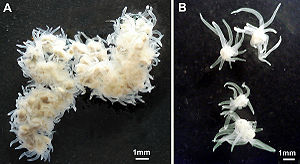Polypodium hydriforme
| Polypodium hydriforme | ||||||||||||
|---|---|---|---|---|---|---|---|---|---|---|---|---|

Polypodium hydriforme , left: stolon, right: free-living stage with tentacles |
||||||||||||
| Systematics | ||||||||||||
|
||||||||||||
| Scientific name of the family | ||||||||||||
| Polypodiidae | ||||||||||||
| Poche , 1914 | ||||||||||||
| Scientific name of the genus | ||||||||||||
| Polypodium | ||||||||||||
| Usow , 1885 | ||||||||||||
| Scientific name of the species | ||||||||||||
| Polypodium hydriforme | ||||||||||||
| Usow , 1885 | ||||||||||||
Polypodium hydriforme is a parasite thatspendsmost of its life in the oocytes of fish from the order of the sturgeon-like (Acipenseriformes). The adult stage lives freely in fresh water. Polypodium hydriforme is the only species of the genus Polypodium in the monogeneric family Polypodiidae .
The systematic position of Polypodium hydriforme was controversial for a long time. Even after more recent studies, the exact position within the cnidarians (Cnidaria) is still unclear.
distribution
For a long time, Polypodium hydriforme was only known from Eastern Europe , where it was known to be a pest in the production of caviar . It was later found in other sturgeon species in large areas of Europe. In 1979 it was first detected in sturgeon species in North America.
Description and life cycle
Polypodium hydriforme resides in the oocytes of sturgeon species (Acipenseriformes) for most of its life . It develops over several years from a binuclear cell (embryo) with a diameter of 15 to 30 μm into a planula- like larva that is almost turned outward and later into an elongated, likewise everted stolon. The eversion probably takes place in the gastrula stage. In both stages of development, the epidermis is inside and the gastrodermis is outside. The embryo, larva and stolon are surrounded by a protective polyploid cell, which also has a digestive function and can absorb nutrients. This situation disappears in the older stages of the stolons. The larva grows to a length of about 2.5 mm before it transforms into the stolon. The stolon can be over two centimeters long and have up to 100 buds. Even at this stage, up to six tentacles per bud are formed, but these are located inside the organism. Shortly before the host spawns, the cell layers of the parasite turn inside out, the epidermis comes to lie on the outside, the gastrodermis on the inside. During this inversion, the future gastric space fills with the yolk of the host oocyte. This provides the parasite with sufficient nutrients for future life in open water. After the host animal's eggs have spawned, the parasites leave the eggs and the stolon breaks down into numerous medusa-like individuals with initially 24 tentacles without a differentiated gastric space. The tentacles are covered with nettle cells (cnidocytes). The nettle cells all belong to the atrich isorhizo type. About two days later, the medusa-like individuals divide lengthways asexually. Most polyps now have twelve tentacles. The gastric space and mouth develop. However, it is not entirely certain whether this medusa-like stage actually corresponds to the medusa stage of the Medusozoa , or rather the polyp stage . With outstretched tentacles they reach a diameter of over one centimeter. After the yolk supply has been used up, little bristles (Oligochaeta) ( Tubifex ), strudelworms (Turbellaria) and rotifers (Rotifera) are also captured. They later reproduce sexually. Little is known about the details so far. The gametophores are already transferred from the adult specimens of Polypodium hydriforme to the pre-larvae with a large yolk supply of z. B. Acipenser stellatus attached. How the fertilized eggs then get into the oocytes is not known.
Systematics
According to the latest molecular genetic studies, Polypodium is a cnidarians. Although this had already been suspected on the basis of the nematocysts, B. a sister group relationship with the Myxozoa has also been postulated. Then the possession of nettle cells would no longer have been unique to the nettle animals. The position within the cnidaria, on the other hand, is less secure. With some likelihood, Polypodium belongs to the Medusozoa (i.e. Hydrozoa , Scyphozoa , Staurozoa, and Cubozoa ). Raikova (1994) established an independent class Polypodiozoa within the cnidarians for this species. The habitat, the fresh water, is also a special feature. However, there are at least two hydrozoan groups that have made the switch to fresh water independently of one another.
swell
literature
- Nathaniel M Evans, Alberto Lindner, Ekaterina V. Raikova, Allen G. Collins and Paulyn Cartwright: Phylogenetic placement of the enigmatic parasite, Polypodium hydriforme, within the Phylum Cnidaria. BMC Evolutionary Biology, 8: 139 2008 doi : 10.1186 / 1471-2148-8-139
- Ekaterina V. Raikova: Life Cycle, Cytology, and Morphology of Polypodium hydriforme, a Coelenterate Parasite of the Eggs of Acipenseriform Fishes. Journal of Parasitology, 80 (1): 1-22, Lawrence, 1996
Individual evidence
- ↑ a b E. V. Raikova, V. Ch Suppes, GL Hoffman. The Parasitic Coelenterate, Polypodium Hydriforme Ussov, from the eggs of the American Acipenseriform Polyodon spathula. The Journal of Parasitology, 65 (5): 804-810, Lawrence 1979
- ↑ Ekaterina V. Raikova: Fine structure of the nematocytes of Polypodium hydriforme Ussov (Cnidaria). Zoologica Scripta, 19 (1): 1-11, Oslo 2005 doi : 10.1111 / j.1463-6409.1990.tb00236.x